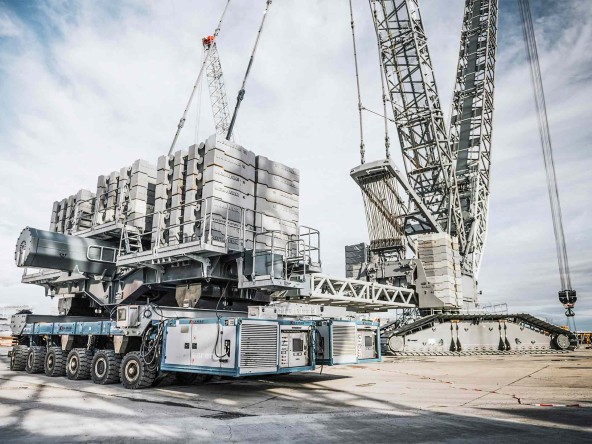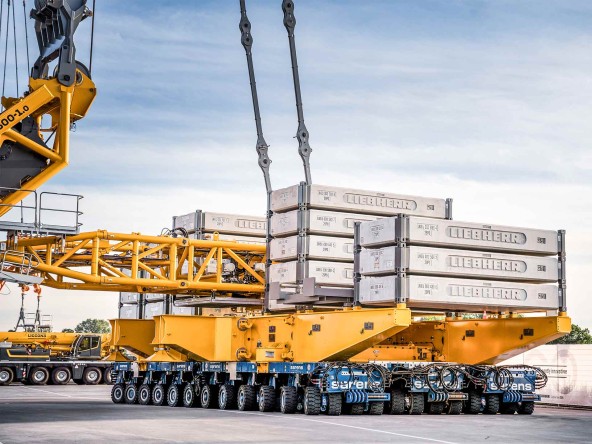
3 minutes - magazine 02 | 2024
New option for the LR 12500-1.0
The purpose of a ballast wagon is to allow a crawler crane with derrick ballast to drive on the construction site regardless of whether it has a load on the hook or not.
SPMTs as a ballast wagon
The crane carries as much ballast as it needs for the heaviest lift during the current job. This allows faster and more efficient working, as there is no need to stack and unstack counterweight plates, unlike with suspended ballast. This also means that an auxiliary crane is not required. However, as a ballast wagon is not used very often, it would be helpful if its components could also be used for other types of work. Our solution: using SPMTs as ballast wagon.

Successful trials have already been carried out with the LR 11000 and SPMTs as ballast wagons.
The idea
This concept is not new, as we have already tried out similar solutions with other crane models. However, SPMTs (Self-Propelled Modular Transporters) have never been controlled directly by the crane until now. Previously, separate personnel had to communicate with the crane operator and control the SPMTs so that it followed the craneʼs movements. Therefore, a solution had to be developed that made it possible to move the SPMTs via the craneʼs control system, just like a standard ballast wagon.

36 SPMT axles are used as ballast wagons for the LR 12500-1.0.
Development process
In close cooperation with the global crane and heavy-duty company Sarens and the heavy-duty vehicle manufacturer KAMAG, we pushed ahead with the implementation of our idea.
KAMAG developed a special control box to ensure communication between the crane and the SPMTs so that the crawler crane can control the movements of the heavy goods vehicles. One helpful aspect of this was the fact that our LICCON control system and the KAMAG control system have a similar basic structure.
The result
Jens Könneker, Product Manager Crawler Cranes, reports: “Liebherr, KAMAG and Sarens have already carried out successful trials with the LR 11000 crawler crane in the recent past. The result was a fully functional solution – circular travel, parallel travel, towing – everything works in exactly the same way as with the standard ballast wagon. We have now transferred this system to our 2,500-tonne crawler crane, the LR 12500-1.0.”
Sarens has already placed an order. The LR 12500-1.0 uses 36 SPMT axles consisting of six 6-axle units. This means that 1,400 tonnes of derrick ballast can be operated with a ballast radius of 25, 30 and 35 metres.
Advantages of using SPMTs as a ballast wagon
- No special wagon is required for a specific crane type.
- If there is no need for a crane with ballast wagon, the crane can be used separately and the SPMTs can carry out other work. This prevents a large investment from not being utilised.
- SPMTs are available worldwide.
- The new SPMT ballast wagon can be used for several crane types: the LR 12500-1.0 and LR 13000 (planned)
- The crane controls the SPMTs. There is an interface between the two machines. The crane is the “master”, the SPMTs are the “slaves”. No separate operating personnel are required (except for assembly).
This article was published in the UpLoad magazine 02 | 2024.



